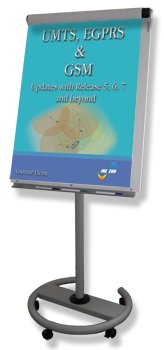 UMTS, EGPRS & GSM
UMTS, EGPRS & GSM
Updates with Rel. 5, 6, 7 & beyond
[3-day course, Euro 3,450.- (net) per participant]
 Overview of important Release 5 Features
Overview of important Release 5 Features

- Major Architectural Changes
- GERAN in A/Gb- or Iu-Mode
- Iu-Flex
- The IP-Multimedia Subsystem
- Iub- and Iu-cs-Interfaces IP-based
- Upgrading the HLR to become the Home Subscriber Server
- Major New Features
- HSDPA
- SIP as IP-based Session Control Protocol
- Additional Multislot Classes
 Detailed Consideration of Selected Release 5 Enhancements and Features
Detailed Consideration of Selected Release 5 Enhancements and Features
- The IP-Multimedia Subsystem
- What is the IMS?
- Service Perspective of the IMS
- Service Types and Service Enablers
- Conversational Services
- Audiovisual Entertainment Services
- Service Enablers - Description of the IMS-Network Architecture Overview
- The IMS within the 3GPP-Network Architecture - The Perspective of the IMS User Agent
- Typical User Agents of the IMS
- Mobile Handset - Today
- Mobile Handset - Future
- IMS-related User Identities - Protocols of the IMS (Perspective of User Agent)
- SIP and SIP-Operation
- Session Description Protocol
- Real-time Transport Protocol (RTP)
- Session Setup Example through SIP
- GERAN-Operation in Iu-Mode
- Core Network Interconnection using Iu-Interfaces
- Protocol Stacks / Packet-Switched Domain
- Control Plane
- User Plane - Physical Channels in Iu-Mode
- Logical Channel Mapping Rules on DBPSCH
- Logical Channel Mapping Rules on SBPSCH
- Channel Mapping Example
- The Iu-Flex Feature
- Packet-Switched Pool Areas
- Circuit-Switched Pool Areas
- Core Network Node Selection Function
- Affected Network Nodes
- HSDPA
- Targets
- Performance Figures
- HARQ-Techniques with HSDPA
- New Channels with HSDPA
- Fast Resource Scheduling in HSDPA
- Timing Relation between HS-DPCCH and HS-PDSCH
 Overview of Important Release 6 Enhancements and Features
Overview of Important Release 6 Enhancements and Features
- Architectural Changes
- Adoption of Alternative RAT’s
- Access Network Sharing
- Architecture Option 1: GWCN
- Architecture Option 2: MOCN
- Operation in case of MOCN - MBMS
- Major New Features – UTRA-related
- Introducing HSUPA
- Introducing Advanced Receiver Performance
- The HSDPA-Enhancements
- Additional Frequency Bands for UTRA
- Major New Features – 2G and 2.5G Radio Related
- Packet-Switched Handover in A-/Gb-Mode of Operation
1 Operation / Message Flow - Multiple TBF’s in A-/Gb-Mode of Operation
- Flexible Layer One (FLO)
- Packet-Switched Handover in A-/Gb-Mode of Operation
- Major New Features – Upper Layers
- IMS-Enhancements
- Generic Authentication Architecture (GAA)
- UL-TDOA
- W-AMR+ Codec
- EAP-SIM and EAP-AKA
 Detailed Consideration of Selected Release 6 Enhancements and Features
Detailed Consideration of Selected Release 6 Enhancements and Features
- MBMS
- Detailed View on the MBMS-Protocol Stack
- User Service Level
- Bearer Level - New Channels with MBMS
- Detailed View on the MBMS-Protocol Stack
- HSUPA
- Performance Considerations
- Multicode Operation with HSUPA (Category 6 User Equipment with 4 x E-DPDCH)
- The I/Q-Plane View of HSUPA: Is it really QPSK?
- Practical Exercise: Determine the Sum-Signal of the Q-Branch for this Category 6 UE - The Protocol Stack of HSUPA
- Operation of HSUPA
- Review: SIR Considerations in a CDMA-system
- Resource Sharing of UL-Resources in HSUPA
- Absolute Grants and Relative Grants - Description of the new Channels with HSUPA
- Adoption of Alternative RAT’s
- Interconnection Options for Alternative RAT’s
- I-WLAN Operation from the User’s Perspective - Security Procedures in case of alternative RAT’s
- The EAP-SIM Procedure
- The EAP-AKA Procedure
- IKEv2 - Details of GAN/UMAN-Access
- Network Architecture
- Mobile Station Operation Modes
- Protocol Stacks
- Operation - Details of I-WLAN Direct IP-Access
- Network Architecture
- Attachment and Operation - Details of I-WLAN 3GPP IP-Access
- Network Architecture
- Protocol Stack
- Attachment and Operation - Practical Exercise: Differentiation of Alternative RAT-Interconnection Options
- Interconnection Options for Alternative RAT’s
 Outlook to Rel. 7 and LTE (Long Term Evolution)
Outlook to Rel. 7 and LTE (Long Term Evolution)
- IMS-Enhancements with Release 7
- Use of Arbitrary IP-CAN
- Addressing of NAT/NAPT-Issues
- Security Enhancements
- Downlink Dual Carrier Operation with Release 7
- Reasons and Preconditions
- Operation and Channel Allocation
- Implications for existing Procedures
- MIMO in 3GPP-Networks
- The Basics: Signal Fading Physics between Tx and Rx
- Multiplexing Dimensions
- The Multipath Dimension
- Zoom into Rx1
- Equalization – Distinction of Tx1 and Tx2 - Characteristics of SAIC
- Application in MIMO-Systems
- Increased Spectral Efficiency and Higher Data Rates
- The Look Ahead: 3GPP’s Long Term Evolution
- Overview
- The AIPN (All IP Network)
- E-UTRA
- Ideas and Objectives
- Network Architecture
- Introduction to OFDM and its use in E-UTRA
v1.51
ℹ️ Try out the updated search below!
Search:
More Info:
General Information about this course
Schedule of this training course
Extract of this training course
Buy this book
INACON eBooks
Please have a look at our full offer

